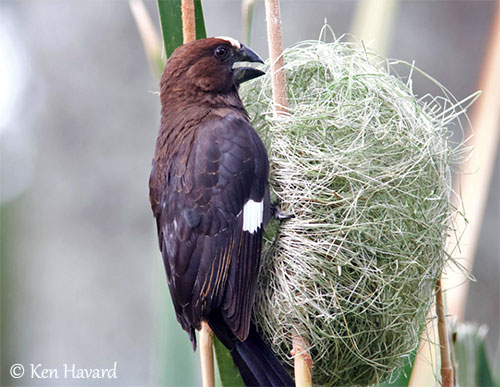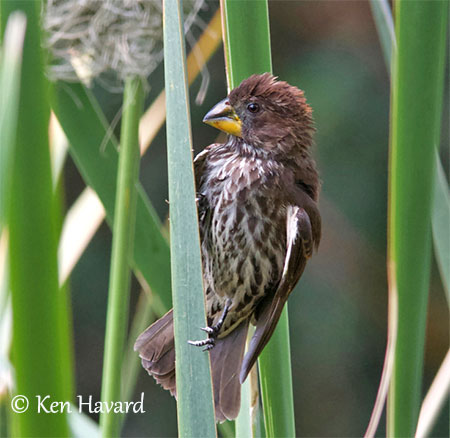
Fr: Amblyospize à front blanc
Ang: Thick-billed Weaver - Grosbeak Weaver
All: Weißstirnweber
Esp: Tejedor Picogordo
Ita: Tessitore beccogrosso
Nd: Dikbekwever
Sd: tjocknäbbad vävare
Photographers:
John Anderson
John Anderson Photo Galleries
Callie de Wet
GALLERY
Ken Havard
My Bird Gallery & Flickr gallery 1 & Flickr gallery 2
Philip Stapelberg
GALLERY
Text by Nicole Bouglouan
Sources:
HANDBOOK OF THE BIRDS OF THE WORLD Vol 15 by Josep del Hoyo-Andrew Elliot-David Christie - Lynx Edicions – ISBN: 9788496553682
BIRDS OF AFRICA SOUTH OF THE SAHARA by Ian Sinclair and Peter Ryan - Princeton University Press Princeton and Oxford - ISBN: 0691118159
The Birds of Africa: Volume VII – C. Hilary Fry, Stuart Keith – Editeur: Bloomsbury Publishing, 2020 – ISBN: 1472986563, 9781472986566 – 724 pages
BIRDS OF SOUTHERN AFRICA – By Ian Sinclair, Phil Hockey and Warwick Tarboton – Princeton Field Guides - Princeton and Oxford – ISBN: 0-691-09682-1
ROBERTS BIRDS OF SOUTH AFRICA by G. R. Mc Lachlan and R. Liversidge – The Trustees of the John Voelcker Bird Book Fund – ISBN: 0620031182
Wikipedia, the free encyclopaedia
Thick-billed Weaver or Grosbeak Weaver
Amblyospiza albifrons
Passeriformes Order – Ploceidae Family
INTRODUCTION:
The Thick-billed Weaver, also named Grosbeak Weaver, is a large, dark brown Ploceidae with a massive bill giving the bird its name.
It is found in West, East and Southern Africa and ten subspecies share this large range.
It frequents marshes or reedbeds during the breeding season, and can be seen at forest edges while foraging on the ground or in the canopy. It feeds on various seeds, berries and fruits.
The Thick-billed Weaver or Grosbeak Weaver breeds in wetlands. A beautiful woven nest attached to two vertical supports, usually reeds, is built by the male.
This species often breeds in small colonies. The males may be polygynous with up to six females, although the pairs are probably monogamous in low density areas.
The Thick-billed Weaver or Grosbeak Weaver is described as locally common and currently, the species is not globally threatened.

DESCRIPTION OF THE BIRD:
Biometrics:
Length: 18 cm
Weight: M: 45-61 g – F: 36-45 g
The Thick-billed Weaver male of nominate race has dark brown plumage overall. Upperparts, throat and underparts are dark chocolate-brown. Upperwing and tail are mostly blackish-brown. A white wing patch is formed by the white primary bases. This patch is conspicuous in flight, but it is also visible on folded wings.
On the underparts, the feathers from lower breast to vent may have paler fringes, forming scaled pattern.
On the dark brown head, the forehead is white. However, this frontal band shows individual variations in extent.
The massive bill is blackish to dark grey. The eyes are dark brown. Legs and feet are dark grey to black.

The female is smaller and paler than male. The upperparts are dark brown with buffy scaling effect. Wings and tail are dark brown with paler edges to wing-coverts. Some females may show the same wing-pattern of the male.
The underparts are whitish with heavy brown streaking. The thighs are brown. The undertail-coverts show blackish-brown centres.
The heavy bill is dull brown to orange-yellow.
The eyes are brown.
Legs and feet are grey.

The juvenile resembles female but it has yellowish bill. The adult plumage needs at least two years to be complete.
SUBSPECIES AND RANGE:
The Thick-billed Weaver has ten subspecies, but this number may change depending on the different authors.
The northern races have chestnut head (not dark brown) and paler brown back.
Among the subspecies, the nominate race A.a. albifrons (described above) is found in eastern South Africa.
The race A.a. capitalba from Senegal to SW Nigeria shows more extended white frontal area. Hindcrown, nape and chin to breast are pale rufous-brown and contrast with the dark chocolate-brown of upperparts, wings and tail. The belly is grey-brown.
A.a. melanota from S Sudan, SW Ethiopia, E DR Congo, Uganda, W Kenya, Rwanda, Burundi and NW Tanzania shows a smaller white frontal area in male.
A.a. montana from interior of Kenya and Tanzania, SE DR Congo, Zambia, Malawi, N Botswana and NW Zimbabwe is very dark, with almost black head, breast and upperparts.
A.a. unicolor from S Somalia, coastal Kenya and Tanzania, Zanzibar and Pemba Island, is similar to A.a. montana but it is smaller. The male may show some brown tinge on the head.
The other subspecies such as A.a. woltersi from Manhica in S Mozambique, is synonymized with the nominate race.
A.a. saturata from Cameroon and A.a. tandae from N Angola are synonymized with A.a. capitalba.
A.a. kasaica from SE DR Congo and A.a. maxima from Chobe in Botswana, are synonymized with A.a. montana.
But more study is required.

HABITAT:
The Thick-billed Weaver breeds in wetlands, and more generally near water and wooded areas. It builds the nest in marshes, near rivers, reedbeds and Papyrus beds.
Outside of this period, it occurs at the edges of evergreen forests, often far from water. These birds also roost in flocks in tall grass and reedbeds.
The species is visible from 850 to 3,000 metres of elevation, depending on the range.
CALLS AND SONGS: SOUNDS BY XENO-CANTO
The Thick-billed Weaver gives a loud “chuck” as contact call.
During the nest-building, we can hear a harsh chattering described as a mixed series of trills and clicking notes.
In flight, it utters a high-pitched “tweek tweek” or “pink pink”.
BEHAVIOUR IN THE WILD:
The Thick-billed Weaver feeds mainly on fruit and seeds from several plant species, but insects are also part of its diet. It also eats berries of Chaetachme aristata.
The heavy bill allows the bird to open or remove any hard coating.
It usually forages at the edges of the evergreen forest, but also in forest canopy, even far from water.

The Thick-billed Weaver is often polygynous and a single male may attract and mate with up to six females, and three nests may be active in the male’s territory.
However, in areas where these birds are found at low density, the pair is apparently monogamous. But they usually form small colonies, with some exception in South Africa where a colony contained more than 100 nests.
The displays take place near the nest where the male performs a slow, flapping flight. If the female approaches, the perched male displays the white wing patches while rotating the wings forwards. The tail is jerked up and down. These displays are accompanied by song.

The Thick-billed Weaver is resident with some local movements related to foraging areas.
The flight is undulating like that of the woodpeckers, with flying periods interspersed with gliding.
REPRODUCTION OF THIS SPECIES:
The breeding season varies depending on the range.
The Thick-billed Weaver nests in Papyrus or Bulrush reeds. A small territory is defended around the nest.
This species may breed in small colonies and the males are polygynous, but in low density areas, the pairs are probably monogamous.


The male builds the nest, a compact, oval structure between two vertical reeds. This globe-shaped nest is woven with thin strips of rushes. The walls are thick. The side entrance is placed near the top of the nest.
The nest-building is complex, starting as a strip between two reeds, then added to behind like a basket, and then upwards and over the top until reaching the front where it is closed up around the entrance.
Some nests may have a larger entrance, and are probably used for roosting.
After mating, the female lays 3 whitish pink eggs with red, purple and brown spots. She incubates alone during 14-16 days. She feeds the chicks by regurgitation until they fledge, and the male may occasionally help to feed the young.
The chicks fledge about 18-20 days after hatching.
The nests are sometimes parasitized by the Deiderik Cuckoo, but predators such as the White-browed Coucal, the House Crow and the Nile monitor sometimes affect the breeding success.
PROTECTION / THREATS / STATUS:
The Thick-billed Weaver is described a locally common to abundant, depending on the range.
This species has benefited from dams and wetlands created by humans. These man-made structures have resulted in the presence of the species in inhabited and urban areas.
The size of the population is unknown, but it is suspected to be stable and not globally threatened.
The Thick-billed Weaver is currently evaluated as Least Concern.
